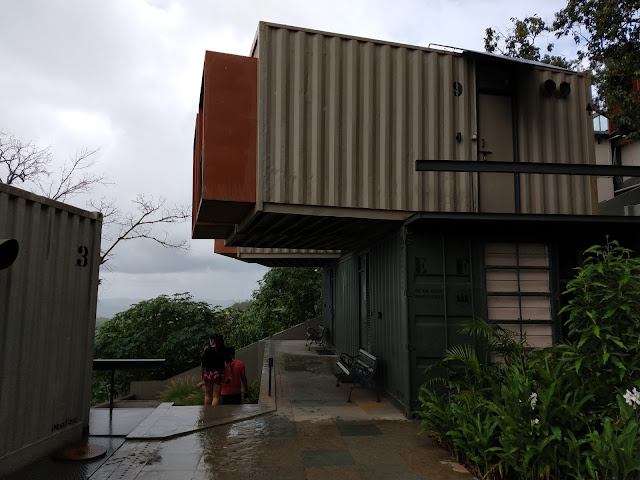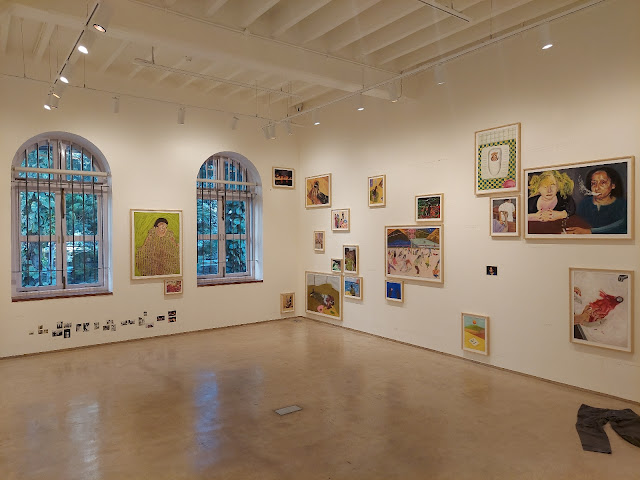QUICK GLOSSARY :FORM: a specifically orchestrated experience
EXPERIENCE:
(a) sensorial - perceived through the senses
(b) mental perceived within the mind. psychologicalCONSTRUCTED: any thing that is intervened and mediated by human agency.ENVIRONMENT: the overall condition we come to inhabit
Therefore in most design studios, the expectation or ambition is to produce a relationship between the component elements that is not conventional , or something that does not appear familiar - avante garde say. Moreover or otherwise, sometimes, it can also be about producing a relationship that affirms a certain register to amplify an existing learnt aesthetic experience. Nevertheless, most design studios operate upon the thrust of producing something radical - something radically new. In this motion, (to address or even orchestrate the question of new), new processes need to be set. (A new apparatus will yield a new form - is the assumption).
How do we achieve new apparatuses? how do we produce new processes?
In creating these apparatuses and thereby forms, often two things are principally mobilized:
a. Translation
b. Abstraction
Translation happens from one disciplines experience into architecture. For example, accessing a piece of literature or music, or dance, to work with its aesthetics to be experienced through architectural space and form. For example, how does text become a building / architecture? Or how does music become form? It is understood rightfully that each of these allied disciplines of literature, music, performance , theatre, dance, etc. - hold and work with an aesthetic apparatus, and result into an aesthetic form, having their own internal aesthetic question. However in order to innovate internal architectural thinking, one harks into another discipline to / in hope of deriving a new form for one's own discipline. However, this happens through not-so-tried or tested methods of translation from one register to another. What is it that we translate, when we translate from one language into another? Translation requires immense maturity. Moreover, in order to translate, one must have complete or proficient command over the primary material language from which it would be translated into. Often, nor students neither the teacher have command f the aesthetic language of the primary base material. Examples, if one wants to translate music (say Hindustani Classical) in architectural form, he/she must have great command over the understanding of its structure and inner workings (and therefore its form - and thereby its limitations). However, in many (most) cases, both, the student and the teacher approach the first medium with a cursory or impressionistic understanding of it. It is possible however that
a. the either party has a strong training into the structure of base art form
b. that either part has developed faculty to understand and interpret another art form's nuances through an innate understanding of one's own disciplinary structure.
In either case, these relationships and their gaps are not acknowledged or even made explicitly; and are left to the task of interpretation. It is believed that interpretation will yield interesting vectors for aesthetic exploration. However, it is here, that we encounter the vagaries of 'subjectivity'.
Interpretive processes are often validated through the trope of / under the guise of 'subjectivity'. "I like", "I thought"... are lines of argumentation that students often adopt and these are also interrogated by teachers using cultural contra-positions such as "but in this culture...", "but why this association..." Here, while the Pandora box of associative understanding is opened up, it more often than not is convoluted in certain web of power (of the teacher) and unfamiliarity (of the student).
The more important thing however is that the "subjectivity" that is mobilized is often uncritical. Meaning - that the "I" is often not methodically interrogated. Where does one get one's subjectivity from? Subjectivity - one's own perceptual associations - that drive aesthetic experience of any object or environment - do not come rom vacuum. They are mostly embedded in a socio-cultural setting. they may also be located in various other frames which critical Theory has amply addressed. Without engaging in Critical theory, the mobilization and assumed acceptance of subjectivity and its associations seem unreliable. Moreover, even if not critical theory, subjectivities depend on processes of self-identification - in processes of identity formation. More often than not, our subjectivities are heavily preconditioned by social processes. How do we de layer them? And in other cases, for people who experience new subjectivities may not have the language to express it (take for example queer experience - who often find it hard to put words to their experience because language itself is so wrangled into heteronormative forms).
Thus in order to locate one's subjectivity, one needs to necessarily in Critical Theory, or a deep investigation of the self. Have we considered such scientific-humanities engagements before we delve into process of translation? I also feel that several experience become accessible to us only through the function of age and time (take for example puberty, adolescence and the related socio-psychological impositions along with ofcourse its material physical effects felt within the body, or the experience of family, or giving birth, or the frailness of living and old age, and so on). Therefore, how does one sensitize oneself to the vagaries of subjectivity before the act of jumping into translation, is a questionable aspect. It hints at the politics of associativity in aesthetics.
The second is the process of abstraction. Abstraction processes are central to all creative processes. Here, reality, or aspects/ fragments of the real are left behind in order to reveal a certain sub structure, or meta structure that hold "form" together. Abstraction however holds the promise of preserving the 'essential'. The 'essential' is the key value, or the defining quality of an aesthetic object into consideration. Abstraction also hopes to hold this essential while possibility orienting us to / crystallizing into a different form. In this line of thinking, the procedural apparatus acts as a filter of sorts to reality, which allows to retain certain aspects of chosen form to work into a new form. Abstractive processes are valuable since they hold the potential to produce larger (a more generous) common ground for the confluence of different disciplines to draw from each other They also help in reducing the amount of information to be processed from an object - the amount of information one has to parse to make an observation knowledge-worthy. However, the processes of abstractions can often become (mechanical) to hold any meaning for the person operation. This is a question of heuristics. How does the apparatus of translation become meaningful and how does one validate the aesthetic acuity of such apparatuses?
Thus, responses produced within the unresolved questions of 'subjectivity' and 'abstraction' require more grounding. The student entering the course of design at the age of 18 - I assert - is necessarily underexposed to the complexity of one's own identity (and thus subjectivity) as well as unaware of the notion of abstraction. Moreover, identity itself is malleable, in formation, and in fact, design education institutions are themselves prime machines that shape specific design identities (to put it popularly - "schools of thought", or "ways of seeing") amongst their students. How does one conceive of pedagogic processes with such transforming dynamics of the self?
While these are preliminary deliberations on the pedagogic aspect of things, the story on the other side needs a critical evaluation too. What does the student really take back from the engagement in such processes about form - about architectural form? Does the student understand the connection between the base art form and the resultant architectural produce which we call architectural space? Are they able to appreciate the intricacies of the base art form more closely than before, or are they able to appreciate notionally the structure of aesthetics in general? What precisely have they absorbed in this process of translation that was essentially orchestrated for them? Did they understand this as an act of translation at all, if the work of architecture could be to offer functionally meaningful solutions. I am not sure if students ever arrive at this question - and how, or when? And how d we evaluate what kind of subjectivity we have eventually shaped? These are questions that often get buried under the eventual production of a seemingly novel looking architectural form. Could it be possible (in this stream of thought) that two completely different looking forms have the same experience - in linguistic / diagrammatic parlance, certainly yes! However, how do we then hold what is essential to architecture" This is not a burning question, rather a tickling question (almost a laughable one)!
to be continued...














































